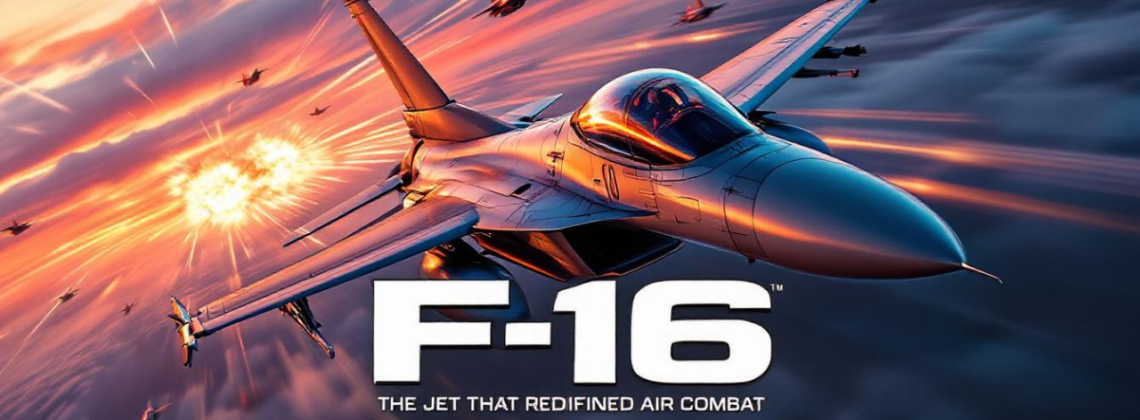
In the world of aerial warfare, where split-second decisions determine victory or defeat, few aircraft can match the legacy of the F-16 Fighting Falcon. Known among pilots as the “Viper,” this sleek and lethal machine has dominated the skies for over four decades, securing its place as a symbol of tactical supremacy. But what makes the F-16 so extraordinary? Let’s take a closer look at the design, history, and combat achievements that have cemented its legendary status.
The Birth of a Game-Changer
When the F-16 first took to the skies in the 1970s, it wasn’t just another fighter jet—it was a revolutionary leap in aerial combat design. Developed by General Dynamics (now Lockheed Martin), the Falcon was created to address the need for a lightweight, highly maneuverable fighter capable of outmatching any adversary. Its groundbreaking fly-by-wire control system offered pilots unmatched precision during high-speed maneuvers, setting it apart from the mechanically controlled aircraft of the time.
Weighing approximately 19,700 pounds empty and capable of speeds exceeding Mach 2 (over 1,500 miles per hour), the F-16 combined raw power with agility. With features like a bubble canopy for 360° visibility and the ability to sustain 9 G turns, the Falcon was—and still is—a pilot’s dream machine.
Falcon vs. Hawk: A Study in Contrast
To truly appreciate the F-16’s dominance, consider its performance against older platforms like the BAE Hawk. While the Hawk is a respected trainer and light combat aircraft, it was never designed for high-stakes, front-line combat. The Hawk’s maximum speed of Mach 0.84, limited weapons loadout, and less advanced avionics made it no match for the Falcon’s superior speed, agility, and firepower.
As one expert put it, “The Falcon devours Hawks.” This was evident in combat simulations and real-world scenarios, where the F-16 consistently outclassed older-generation jets.
Legendary Combat Record
Over the years, the F-16 has proven its worth in numerous conflicts, showcasing its versatility and combat prowess. During Operation Desert Storm in 1991, F-16s flew over 13,000 sorties—more than any other aircraft. While primarily tasked with strike and interdiction missions, the Falcon excelled in air-to-air combat, demonstrating its adaptability in chaotic battle conditions.
Another striking example of its dominance occurred during the Balkans conflict in 1999. In a famous engagement, an F-16 pilot, Lieutenant Colonel Michael “Gixi” Geczy, shot down a Serbian MiG-29 using an AIM-120 AMRAAM missile. The Falcon’s advanced radar system detected and locked onto the target long before the enemy pilot even knew he was being hunted. This encounter highlighted the F-16’s ability to “dictate the fight” rather than merely participate.
Engineering Marvels That Tip the Scales
The F-16’s design is a masterclass in engineering excellence. Key features include:
- 360° Bubble Canopy: Provides unparalleled situational awareness, giving pilots a crucial edge in dogfights.
- Fly-By-Wire Controls: Enhances maneuverability and allows pilots to execute tight turns with ease.
- Advanced Weaponry: Equipped with the M61 Vulcan 20mm cannon for close-range combat and missiles like the AIM-120 AMRAAM and AIM-9 Sidewinders for both short- and long-range engagements.
- Radar Systems: The AN/APG-68 radar enables the Falcon to track multiple targets simultaneously, ensuring dominance in complex air battles.
These features, paired with rigorous pilot training, have made the F-16 a force to be reckoned with in both real and simulated combat scenarios.
The Falcon in the Modern Era
Despite being a fourth-generation fighter, the F-16 continues to evolve. Modern variants like the F-16V “Viper” are equipped with cutting-edge technologies, including AESA radars, data link systems, and helmet-mounted queuing systems that allow pilots to fire missiles simply by looking at the target. These upgrades ensure the Falcon remains a relevant and formidable adversary even in an age of fifth-generation fighters.
Today, over 25 countries operate the F-16, with more than 4,600 units produced. Its adaptability for multi-role missions—seamlessly switching between air-to-air combat and bombing runs—further solidifies its reputation as one of the most versatile and reliable aircraft in history.
A Legacy of Supremacy
From dueling MiGs in the Balkans to dominating NATO exercises with kill ratios of 4:1, the F-16 Fighting Falcon has repeatedly proven its worth. It’s not just an aircraft; it’s a symbol of innovation, strategy, and engineering excellence. Whether defending allied airspace or leading offensive missions, the Falcon remains a relentless predator, agile, intelligent, and always ready to hunt.
Conclusion
The F-16 Fighting Falcon isn’t just a fighter jet—it’s a testament to what happens when exceptional design meets unmatched performance. It’s a warplane that has shaped the course of modern air combat and continues to do so with cutting-edge upgrades and innovations. As aerial supremacy remains a defining factor in global conflicts, the Falcon stands as a reminder of the power of human ingenuity and determination.
What do you think about the legacy of the F-16? Can it continue to hold its ground against the next generation of fighters? Share your thoughts below and join the conversation about this legendary aircraft! 🚀
